A Visual Guide to AWS
Oct 15, 2006, 11:04 PM by Rich Brome
Everything you wanted to know about AWS but were afraid to ask, plus frequency bands explained.
Intro
The U.S. government recently auctioned off a large, important band of radio spectrum called AWS. There's a lot of confusion about the new AWS band these days, so we've created this handy guide to explain all the nitty-gritty details.
Although this article focuses primarily on AWS, it's hard to explain AWS without touching on some general radio spectrum topics and the other major cell-phone bands, so we'll cover some of that, too.
The AWS auction was conducted by the FCC (Federal Communications Commission,) the arm of the government responsible for (among other things) regulating radio spectrum and the industries that use it. The auction took place August 9 - September 19, 2006.
AWS stands for Advanced Wireless Services, although that's really not important. The FCC gives each band a name mostly just to make them easier to refer to. AWS, PCS, BRS, WCS... are all just arbitrary names for bands.
Each band is designed with certain types of services in mind, and therefore has some rules associated with how it can be used. AWS was designed with "3G" mobile phone service in mind, so it does come with rules that would make it unsuitable for wildly different uses like satellite communications or TV broadcast, for example,
However, in keeping with our government's free-market policies, the FCC does not usually mandate that specific technologies be used in specific bands. Therefore, companies that are proud new owners of AWS spectrum are free to use it for just about any 2G, 3G, 4G, or future mobile phone (or similar) technology, as they see fit. This is in contrast to Europe and some other parts of the world, which do mandate that specific technologies (like GSM or WCDMA) be used in each band.
One critical thing to understand about radio spectrum is that it's all allocated for something. Spectrum is a limited and extremely valuable resource. There is very little "empty" spectrum that isn't used for anything. In fact, this is what the US radio spectrum allocation chart looks like:
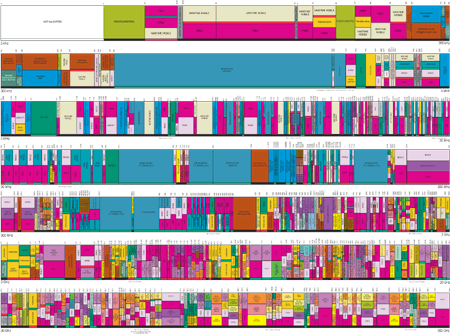
Each little section of that chart has a different use. Some is used by the military, police and firefighters. Other parts are allocated to boats and planes, and satellites take a fair chunk as well. RADAR uses radio waves, so there are bands for that, too.
The huge blue sections you see are for analog TV and FM/AM radio broadcasts. Obviously they take a huge chunk of spectrum, which is why the move to digital TV is so important; it's much more efficient and will free spectrum for other uses. Some UHF analog TV channels have already been freed up and sold to companies that will use them for live digital TV broadcasts to cell phones.
So if the spectrum is so crowded and all in use, where did the AWS band come from? Some of it was actually very rare unallocated spectrum, but much of it was used by the government, including the Department of Defense. Therefore, in December 2004, congress ordered the DoD to vacate that spectrum, and established a Spectrum Relocation Fund to pay for replacing all radio equipment using that spectrum with new equipment that will use different spectrum.
That kind of relocation is very difficult and expensive, which is why it doesn't happen often. It's also why the FCC has very limited options when trying to carve out "new" spectrum to auction off.
All cell phone service requires radio spectrum bands to operate in. Companies offering cell phone service need licenses from the FCC in order to use those bands.
Such licenses are usually sold at auction, but those auctions are rare, and once the licenses are sold, the winning bidders then have a lock on that spectrum. New companies entering the market can't just buy new licenses; they generally have to find some way to deal with the companies that hold the existing licenses.
The same is true for existing companies that find they need more spectrum. Each call and each data connection takes up a bit of spectrum, so as the population grows and more people use cell phones, networks require more spectrum to handle the additional calls and data usage.
Upgrading to new "3G" technologies also requires additional spectrum. Newer technologies are more efficient, but companies usually need to keep the old networks running for many years while they roll out the new technology and transition to it, so customers with old phones aren't left behind. Often the new and old technology each need to run in their own separate chunk of spectrum, (as is the case with EVDO and WCDMA,) so a surplus of spectrum is required to make such upgrades.
But companies can't just knock on the FCC's door and say "more spectrum please." That's part of what motivated Cingular to buy AT&T Wireless, and Sprint to buy Nextel. Spectrum is valuable enough to drive large mergers and acquisitions just to obtain more of it.
Large spectrum auctions by the FCC have historically happened about once a decade, but technology seems to be moving faster and requiring more spectrum these days, and no one knows for sure when the FCC will be able to auction off more spectrum after AWS.
All of this is why spectrum is the strategic asset for any wireless company.
Lack of spectrum is why T-Mobile hasn't been able to launch 3G before now. Lack of spectrum also hindered Verizon's EVDO rollout in some areas, until they found a company willing to sell them existing licenses in those areas.
Conversely, a surplus of spectrum is what has enabled Sprint to rent out its network to a large number of new MVNOs, without worrying about running out of spectrum for its own customers.
That's why AWS spectrum is so valuable, and why most of the large industry players plunked down megabucks to buy some of it, even if they don't yet know what they're going to do with it. No wireless company wants to end up needing more spectrum five years from now, and not able to get any.
Bands
Radio spectrum refers to the whole range of radio frequencies. Radios can transmit on different frequencies in the same area at the same time without interfering, so frequency is a handy way to divide up the airwaves for different uses.
Frequency is measured in Hertz, which is abbreviated Hz. The whole range of radio spectrum is pretty huge: 10,000 - 300,000,000,000 Hz. The metric system is used to abbreviate that, so 300,000,000,000 Hz would typically be written 300 GHz.
Different frequencies have different natural properties. Lower frequencies travel farther and penetrate solids better, while higher frequencies can carry more information (faster data rates, etc.) The best balance of these properties for the purpose of cell phones is in the range of roughly 700 - 2,500 MHz. (2,500 MHz could also be written 2.5 GHz, since 1 GHz = 1,000 MHz.)
A specific range of frequencies allocated for a specific purpose is called a "band". The existing "2G" bands for cell phones are shown below:
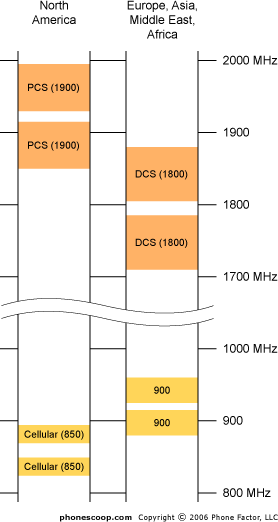
As you can see, there are two major existing bands in North America: Cellular and PCS. There are also SMR bands used for iDEN, but that's a whole 'nother can of worms, so we're skipping those for now to keep things simple.
(If you're wondering why there are two sections of each band, just hold your horses... I'll get to that.)
You can also see that Europe has similar bands, but they don't quite match up. There is a global organization that tries to "harmonize" global spectrum use and avoid what happened above, but it's not always possible. Just imagine the complexity of the US spectrum chart on the previous page, multiplied by every country on the planet, (since each country ultimately manages its own spectrum,) and you'll start to understand how hard it can be to coordinate these things globally.
In the chart above, the lower bands came first. They were the original bands for cellular phone service. North America's upper band - PCS - was auctioned off in the mid-90s. It was auctioned off in six blocks over several years.
Even though PCS was a sizable chunk of spectrum, and only auctioned off a decade ago, the explosive growth of cell phones in the past decade has left wireless companies (and T-Mobile especially) clamoring for more spectrum.
Although US carriers are allowed to launch "3G" technology in the existing "2G" bands, (and most have already done so,) the existing spectrum wasn't enough to handle everything carriers needed and wanted to do.
The same is true in Europe, where they recently addressed the spectrum shortage by auctioning off spectrum in what's generally called the "2100" band. (It's actually in both the 2100 and 1900 bands, but again, we'll get to that later.)
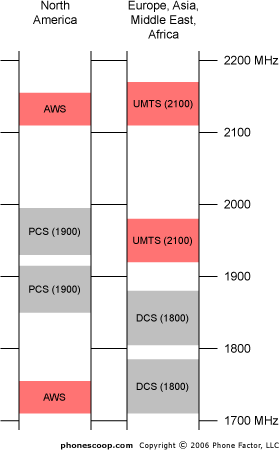
The FCC wanted to harmonize its "new" AWS spectrum with Europe's UMTS 2100 band, since both would be used for new "3G" phone service. Unfortunately, as you can see above, the lower half of Europe's UMTS 2100 band almost completely overlaps with our PCS band, so complete harmonization wasn't an option.
However, given the circumstances, the FCC did do a pretty good job of harmonizing AWS with the rest of the world. The upper part does line up perfectly with Europe's UMTS 2100 band, and the lower part does line up with Europe's DCS band. Therefore manufacturers already building GSM+WCDMA "world phones" actually won't have to support any additional frequency bands at all.
That's not to say that you won't need a new phone to use a network that uses the AWS band; you will. No current phones (as of October 2006) are capable of operating in the AWS band. It's just that the specific bands the FCC chose will make it relatively easy for phone makers to build new 3G world phones compatible with AWS.
So just for the sake of the big picture, here's the whole spectrum situation, including AWS:
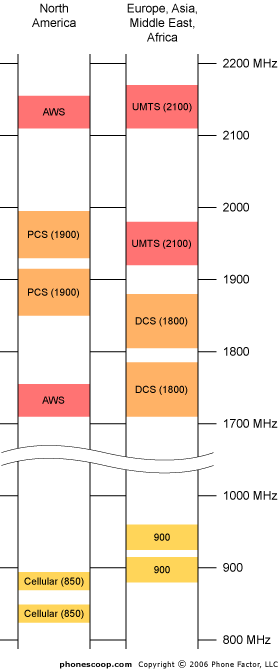
This doesn't include SMR used by iDEN networks like Nextel, nor does it include Japan, which uses its own unique bands. Other parts of the world - such as South America, India, China, and Australia - have allocated some spectrum that aligns with North America, and other spectrum that aligns with Europe.
Now to finally explain why each "band" is really two bands:
All major mobile phone technology to date has used "paired" spectrum. That means each "band" is actually a pair of bands, with one half being used for towers to transmit to phones, and the other half being used for phones to transmit to towers.
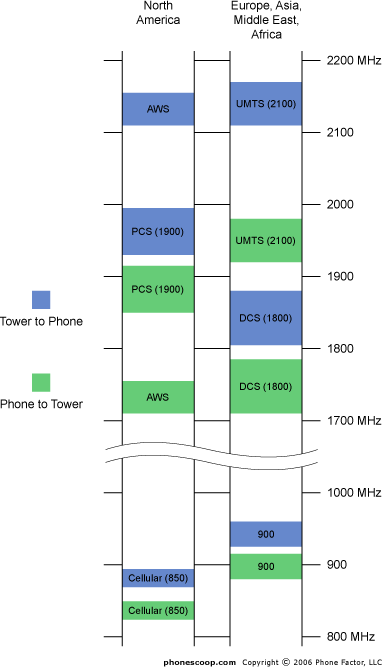
In other words - in the chart above - phones "listen" on the blue bands, and "talk" on the green bands. Vice-versa for towers (which in industry lingo are called "base stations".)
The chart above also shows how each half of AWS aligns perfectly with bands already used in Europe and Asia for communication in each direction.
The chart above also shows why current UMTS 2100 phones aren't compatible with the AWS band. UMTS 2100 phones transmit to towers in 1920-1980 MHz range, which is what towers using the PCS band use to transmit to phones in North America. Therefore UMTS 2100 phones are already designed to not transmit in that range when they're in the US, since that would interfere with PCS networks. Even if that weren't an issue, an AWS network can only "listen" to the 1710-1755 MHz range, so it could never "hear" the 1920-1980 MHz transmissions of a UMTS 2100 phone.
Blocks
Each "band" of spectrum is sub-divided into smaller "blocks". For AWS, the blocks are divided as shown below:
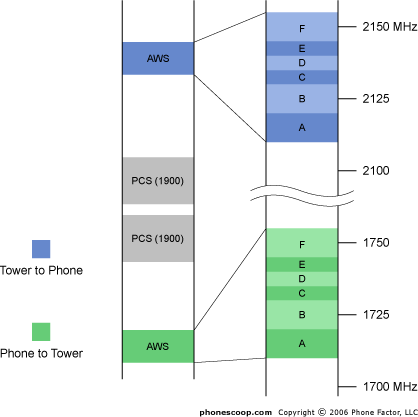
One important thing to note is that some blocks are larger than others. When it comes to AWS, the A, B and F blocks are each 20 MHz wide, while the other blocks are only 10 MHz. That means the A, B and F blocks have twice the capacity, meaning they can potentially handle twice the number of simultaneous phone calls, or twice the data throughput.
Since this is paired spectrum, the A, B and F blocks technically consist of 10 MHz for tower-to-phone, and 10 MHz for phone-to-tower. The C, D and E blocks only consist of 5 MHz in each direction.
None of the AWS licenses are national, though. Rather, the AWS band is not only divided by block, but also geographically. Each license that was sold at auction was for only one block, in one area of the country. Over 1,100 individual licenses were for sale in the AWS auction.
To make things even more complicated, the geographic divisions are not the same for each block. Some blocks are divided up into just a few very large areas, while others are divided up into hundreds of small areas.
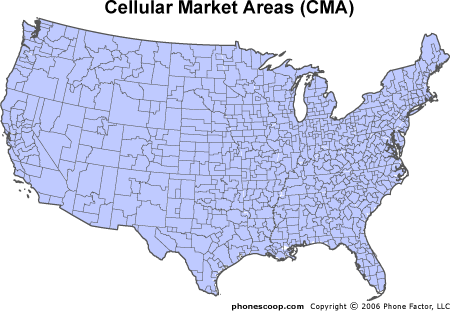
The map above shows how the A block was divided geographically. The divisions are based on CMAs (Cellular Market Areas,) of which there are 734.
(If you've heard of MSAs and RSAs, those are the same as CMAs. MSAs are simply metro areas, while RSAs are rural areas.)
When the FCC sold licenses for Cellular service way back when, it was also based on CMA divisions. That's probably one reason why the FCC chose to offer one block of AWS spectrum divided by CMA: so that smaller companies with existing Cellular licenses could buy new spectrum that matched their existing coverage area.
The FCC also has a duty to use its regulatory power to protect small businesses. Offering AWS licenses that cover relatively small areas is a way to let small local companies get started and expand in wireless.
The B and C blocks are divided geographically into EAs (Economic Areas):
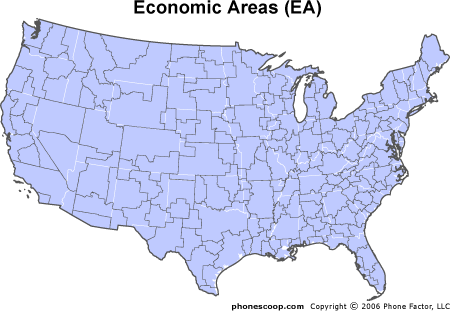
EAs are the medium-size geographic divisions within AWS, being larger than CMAs but much smaller than the next category. There are 176 EAs. (EAs are sometimes also called BEAs in FCC lingo.)
When the Cellular and PCS bands were auctioned off, most cell phone companies were still local or regional. In those days, small divisions of radio licenses made complete sense. But these days, most cell phone service is offered by national carriers, so licenses covering tiny areas complicate things unnecessarily, and, well... just seems silly.
To reflect this new reality of the wireless industry, the FCC decided to auction off half of the AWS blocks based on a new, super-size system of REAGs (Regional Economic Area Groupings.)
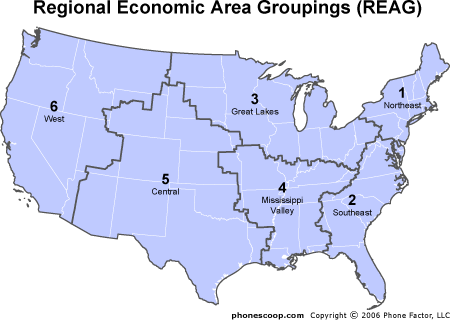
REAG is how the D, E and F blocks are divided. There are 12 REAGs total, but only six main REAGs for the whole continental US. Other REAGs cover Alaska, Hawaii, Puerto Rico, etc.
(REAGs are sometimes also called REAs in FCC lingo.)
Licenses
So the question every sports fan wants to know is: who won?! Who won the AWS auction? The (nice, but somehow unsatisfying) answer is that everybody was a winner. Well, almost everyone....
Although Sprint's joint venture with the cable companies was a big winner, Sprint didn't participate directly. That spectrum won't be used for Sprint-branded service or existing MVNOs, since Sprint has always had plenty of spectrum, and has even more since merging with Nextel. It won't be used to create a whole new, separate wireless phone company, either. Sprint didn't enter into the joint venture to compete with itself that way.
Alltel was curiously absent from bidding. Apparently they think they have enough spectrum already, or that the AWS spectrum was too expensive. It would also seem to indicate that they don't have major expansion plans, or they plan to expand only via mergers and acquisitions.
Pretty much all of the other major players in the biz played the AWS auction game.
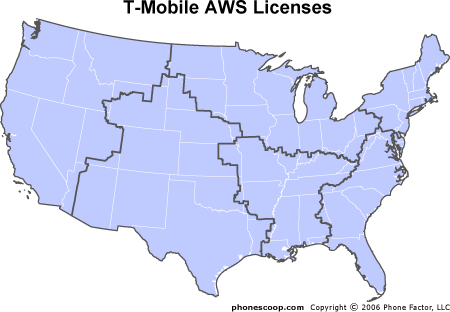
The AWS auction was far more important to T-Mobile than any other company. T-Mobile has, until now, been unable to launch any kind of 3G service due to lack of spectrum. AWS will finally give them the spectrum they need to launch 3G and catch up to the other major carriers.
T-Mobile's new AWS licenses cover the whole country, including Hawaii, Alaska, Puerto Rico, and the Virgin Islands. To cover the whole country, T-Mobile opted to go after the larger, simpler (but more expensive) D-F blocks, which are divided by REAG.
T-Mobile tried to get the coveted 20 MHz F block where they could, but were out-bid by Verizon Wireless in many regions. They did score F block licenses in the Central and West regions, and they picked up both the D and E block in the Southeast.
That left them with only 10 MHz of AWS spectrum in the Northeast, Great Lakes, and Mississippi Valley regions. That might not be enough for major cities, so they beefed it up with an extra 110 A and C block licenses in urban areas. Their biggest A block wins were in the New York and Chicago areas. Their biggest C block licenses are for Philadelphia, Phoenix, LA, and Seattle. That will give them a whopping 30 MHz of AWS spectrum in New York, Chicago, Phoenix, LA, and Seattle.
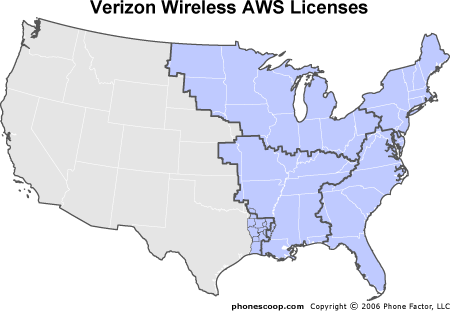
Verizon didn't mess around with the AWS auction. They didn't bother with any of that 10 MHz block nonsense. Every license they won was a big ol' 20 MHz chunk. They even snapped up the most valuable license of the whole auction: the 20 MHz F block for the Northeast. That license alone cost them over $1.3 billion.
They also picked up the valuable F block in the Southeast, Great Lakes, and Mississippi Valley regions, giving them a huge swath of 20 MHz spectrum covering the whole Mississippi river area and everything east of it, well over half the country (in population.)
The only smaller A and B block licenses they bothered with were for Louisiana and Hawaii.
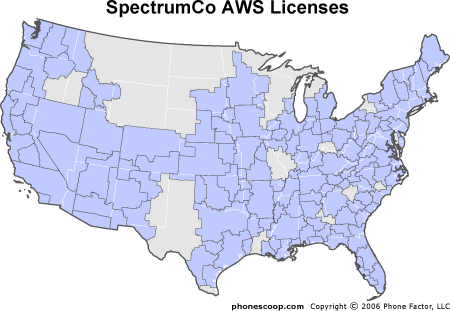
SpectrumCo is Sprint's joint venture with the major cable companies (including Comcast, Time Warner, and Cox.)
They picked up 20 MHz licenses in the B block covering most of the populated areas of the continental US, plus an odd extra 10 MHz in Houston. They also went after Hawaii, although Verizon out-bid them for the B block, so they picked up the C and D blocks there instead.
With the exception of Hawaii, it's an advantage that all of SpectrumCo's AWS spectrum is in one block. It could make it easier for hardware manufacturers to create radios and antennas for just that one very specific frequency band.
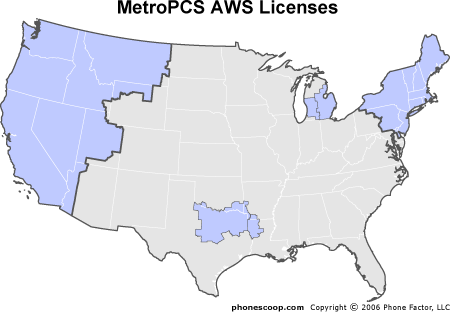
MetroPCS didn't buy very many licenses, but the ones they did buy were pretty darn big. They spent almost $1.4 billion - a huge amount for such a small company. Clearly they are ready to expand in a big way.
By far the most cash went toward the Northeast region, where they bought a 10 MHz regional license, plus an extra 10 MHz license for the all-important NYC metro area. They also greatly expanded their spectrum holdings in the west, buying a 10 Mhz regional license for the whole west coast, plus an extra 10 MHz for the Las Vegas area.
They also picked up some smaller licenses for the Dallas and Detroit areas. They already offer service in those cities, so the new spectrum is presumably to expand capacity and coverage in those areas.
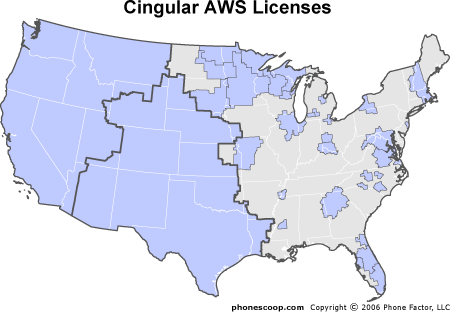
Cingular bought a wide variety of different licenses. There's no one clear strategy or pattern to their purchases. They did spend $1.3 billion, though, so it's doubtful they bought the spectrum just to hold on to for a rainy day.
They picked up two major 10 MHz licenses covering the whole West and Central regions. They also supplemented that with an additional 20 MHz of A block spectrum in LA and Dallas.
They also picked up a smattering of licenses in the rest of the country, in the A, B and C blocks. The largest metro areas covered in that group are Boston, Washington/Baltimore, Miami, Atlanta, and Chicago. All of those were cheaper 10 MHz C block licenses. In smaller cities, they went for the larger 20 MHz A and B block licenses. They also bought the D block in Puerto Rico and the Virgin Islands.
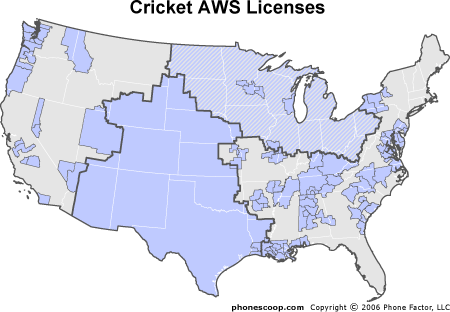
Cricket spent $710 million (directly) in the AWS auction. Their largest purchase was the E block for the Central region, which they managed to snag for $122 million.
The rest of their purchases were mostly in the A and C blocks. Major cities covered include Milwaukee, Memphis, San Diego, Philadelphia, Washington, St. Louis, Baltimore, Minneapolis, and Seattle.
The Great Lakes D block (shown above in diagonal stripes) was bought by Denali, a company set up by Cricket specifically to participate in the AWS auction. Cricket helped start Denali with an initial investment of $7.6 million, which will be followed by an additional $83.9 million over the next year or so. Cricket also loaned Denali $203.8 million to buy the Great Lakes D block, and has promised to loan them another $87.3 million to build a network to use it. While Denali is technically a separate company, with all that money invested, clearly Cricket expects to use Denali's network for Cricket service.
So why go to all that trouble? To qualify for a "bidding credit" that Denali was entitled to as a "very small" company. Denali only had to pay 75% of what they bid. That may seem like cheating, but they were just playing by the rules the FCC created. Taking advantage of the bidding credit loophole saved them over $90 million.
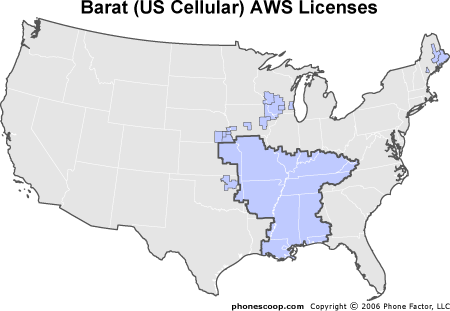
Barat is another "very small" company created to take advantage of the small business rules in the AWS auction. Like Denali, Barat qualified for a 25% "bidding credit" discount.
Barat is backed by US Cellular, which made an initial capital contribution of $80 million to fund Barat's participation in the AWS auction. US Cellular has also promised more money if Barat needs it, which they probably will, since they now owe the FCC $127 million for the licenses they won. Given the financial situation, let's just call this US Cellular spectrum....
So US Cellular's big score was a 10 MHz E block license for the whole Mississippi Valley region. They also picked up a number of 20 MHz licenses in the A and B blocks, including St. Louis, Milwaukee, Tulsa, Des Moines, and Omaha. Their licenses for St. Louis and Topeka overlap with the big Mississippi Valley regional license, giving them 30 MHz total in those cities.
Plans
So what is everyone going to do with this spiffy new spectrum? In most cases, the answer is pretty simple. Most companies will deploy current 3G technologies - such as EVDO revision A and WCDMA+HSDPA - in AWS spectrum.
T-Mobile has already announced plans to build a WCDMA + HSDPA network using the AWS band. In fact, they started planning and building the network even before the auction. For reasons mentioned earlier, it shouldn't be too difficult for phone makers to create GSM/WCDMA phones that support WCDMA+HSDPA in the AWS band.
Although Cingular hasn't announced their specific plans just yet, it would make sense for them to deploy WCDMA+HSDPA in AWS as well. They would be able to take advantage of the same phones and network equipment as T-Mobile. Certainly it wouldn't make sense for them to deploy GSM in AWS, nor would it make much sense to use it for some new technology, since their winnings don't cover the whole country.
Verizon will almost certainly deploy CDMA technology in AWS... eventually. Verizon may choose to wait a while before deploying anything in AWS. They claim to have ample existing spectrum already, and they're one of the few companies rich enough to afford to spend $2.8 billion on spectrum and sit on it for a few years until they need it at a later date.
Regardless of what Verizon does, we're sure to see CDMA phones for the AWS band one way or another, since MetroPCS, Cricket, and US Cellular all use CDMA technology as well.
What specific type of CDMA technology those companies will deploy is not yet clear. Verizon's new AWS spectrum overlaps with their existing spectrum, so they could easily use it exclusively for data using EVDO. The other companies don't have that option. They will be using AWS spectrum for all-new coverage areas, so they need a technology that will support regular voice calls as well.
They may opt to deploy "2G" CDMA 1xRTT for voice, plus EVDO for data, just like they have in existing spectrum. Or they may choose to deploy EVDO rev. A exclusively, using a special kind of VoIP technology to handle voice calls.
To support all of this, companies like Qualcomm have already announced chipsets supporting the AWS band.
The wild card is SpectrumCo, which has publicly announced that they basically don't know what they're going to do with their new spectrum. In announcing plans, they mostly talked about "many options and significant flexibility". They say they might use it in conjunction with their other joint venture to offer Sprint phone service bundled with cable service... or do something completely different.
So what's the bottom line? For T-Mobile, AWS means the ability to finally launch 3G. For Verizon and Cingular, it means the ability to continue expanding 3G and offering more popular 3G services. For MetroPCS, Cricket, and US Cellular, it means dramatically expanding coverage to whole new areas. For SpectrumCo... who knows.
In the end, AWS doesn't represent any kind of paradigm shift for the industry, but it does enable the industry to continue growing in a healthy way. It allows all players to serve more customers, and offer them more.
Comments
Spectrum Allocation chart from the article
http://bookstore.gpo.gov/actions/GetPublication?stoc ... »
I own the past 3 editions... 1990, 1...
(continues)
Cingular Wimax
Alltel??
So is that why...
In other words - in the chart above - phones "listen" on the blue bands, and "talk" on the green bands. Vice-versa for towers (which in industry lingo are called "base stations".)
Scenario:
I am talking to someone on my phone on the 850 band when static starts to come in the listening end, yet when I speak the other party hears me fine.
Is that because my voice is being transmitted in the lower half of 850, therefore able to punch through buildings and go further, but the tower signal, coming on the top half of 850 can't quite connect as well?
Am I putting 2 and 2 together properly, or does the difference of 5-10 MHz not matter nearly that much?
I think it's more just that the send and receive bands are separate, so if there's interference or someth...
(continues)
T-Mobile Spectrum?
In T-Mobile's recent 3G announcement, they claim the AWS spectrum they bought is unfortunately "a few megahertz off from the UMTS 2100 used elsewhere, meaning exis...
(continues)
"a few megahertz off from the UMTS 2100 used elsewhere" isn't really accurate. Th...
(continues)
https://www.phonescoop.co »...
(continues)
(continues)
So, i guess what im asking is it ALL OF BOTH OR NOTHING...
(continues)
(continues)
SUPER article. Thanks Phonescoop!
Will VZW expand into new areas now?
If so, this would be a great advantage to many people, including more choices for consumers.
Cricket and UScellular "just playing by the rules"
anywho, wasn't the FCC trying to discourage this by getting rid of blind bidding? Barat and that other co. just seem like corporate puppets.
Yes, the FCC did try reduce the amount of such shenanigans in this auction, and it is in fact much better than some previous auctions.
Without being an ...
(continues)
AWS causing mergers?


 iPhone 14 Plus Offers a Big Screen For Less
iPhone 14 Plus Offers a Big Screen For Less
 iPhone 15 Series Goes All-In on USB-C and Dynamic Island
iPhone 15 Series Goes All-In on USB-C and Dynamic Island
 Google Testing New Search and Share Features in Chrome for Android
Google Testing New Search and Share Features in Chrome for Android
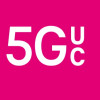 T-Mobile Rolling Out New Icon to Differentiate Fast 5G from Regular 5G
T-Mobile Rolling Out New Icon to Differentiate Fast 5G from Regular 5G
 Google Lens Now Lets You Refine a Visual Search with Text
Google Lens Now Lets You Refine a Visual Search with Text

